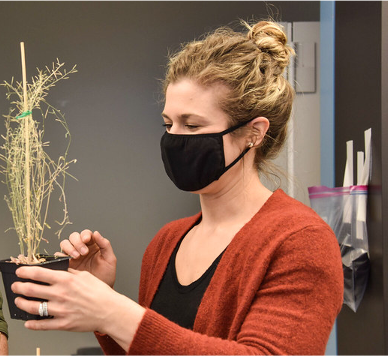Uncovering the genetic basis of seed amino acid composition in Arabidopsis using a multi-omics integration approach
Uncovering the genetic basis of seed amino acid composition in Arabidopsis using a multi-omics integration approach
Seeds are a vital source of protein in the diet of humans and livestock. However, protein composition in the seed is low, comprising about 10% of the total composition in the seed. Additionally, protein quality in the seed is poor due to low concentrations of certain essential amino acids (EAA). Since the body is unable to produce EAA, they must be consumed in the diet and failure to do so has detrimental, potentially irreversible, health implications that can result in death.
Protein in the seed is comprised of free amino acids (FAA) and protein bound amino acids (PBAA) which have both been the targets of manipulation in order to create a seed with a more balanced amino acid profile. However, upon perturbations to the proteome, mutant seeds have demonstrated a rebalancing phenomenon where even large alterations to the amino acid composition activate a compensation mechanism that returns amino acid levels to a comparable composition to the wild-type. To that end, my works analyzes FAA and PBAA composition in Arabidopsis seed.
First, I focus on uncovering the genes and biological processes that underly the regulation of free Glutamine which belongs to the Glutamate Family (Arginine, Proline, Glutamine, and Glutamate). Although Glutamine is not an EAA, it is a major nitrogen-containing amino acid that is transported to the seed; thus it’s regulatory control is of particular interest. I harness the natural variation of Glutamine in a 360 Arabidopsis diversity panel to uncover key regulatory genes. Later, I validate observations from GWAS using both a quantitative trait locus (QTL) analysis and reverse genetic approaches to identify a unique, seed-specific Glutamine-glucosinolate relationship that alters nitrogen and sulfur homeostasis in the seed in the Arabidopsis 360 population. Such finds were substantial as they link primary and secondary metabolism in the seed.
Next, I focus on uncovering the genetic basis underlying PBAA composition in dry Arabidopsis seeds while expanding upon the work completed in Chapter Two. 576 high confidence candidate genes (HCCGs) are found through integration of GWAS using PBAA traits and transcriptomic analysis across seed development of two mutants showing active rebalancing. To reveal the underlying biological process, I further subject the HCCGs to a protein-protein interaction (PPI) network that strongly suggests that ribosomal genes and potentially other translational machinery may be in the heart of PBAA composition homeostasis and the proteomic rebalancing response.
Lastly, I address the need of a comprehensive tool to efficiently and automatically analyze many biochemical derived-traits in GWAS, while also completing pre and post-GWAS analysis. I present the R tool HAPPI GWAS.
Publications
Slaten, M.L., Chan, Y.O., Shrestha, V., Lipka, A.E., Angelovici, R. HAPPI GWAS: Holistic analysis with pre- And post-integration GWAS (2020) Bioinformatics, 36 (17), pp. 4655-4657.
Slaten, M.L., Yobi, A., Bagaza, C., Chan, Y.O., Shrestha, V., Holden, S., Katz, E., Kanstrup, C., Lipka, A.E., Kliebenstein, D.J., Nour-Eldin, H.H., Angelovici, R. MGWAS uncovers Gln-glucosinolate seed-specific interaction and its role in metabolic homeostasis (2020) Plant Physiology, 183 (2), pp. 483-500.
Yobi, A., Bagaza, C., Batushansky, A., Shrestha, V., Emery, M.L., Holden, S., Turner-Hissong, S., Miller, N.D., Mawhinney, T.P., Angelovici, R. The complex response of free and bound amino acids to water stress during the seed setting stage in Arabidopsis (2020) Plant Journal, 102 (4), pp. 838-855.
Committee
- Dr. Ruthie Angelovici (Chair)
- Dr. Chris Pires
- Dr. Libby King
- Dr. Trupti Joshi

Marianne Slaten
Ph.D. Candidate - Angelovici Lab
Division of Biological Sciences
University of Missouri
